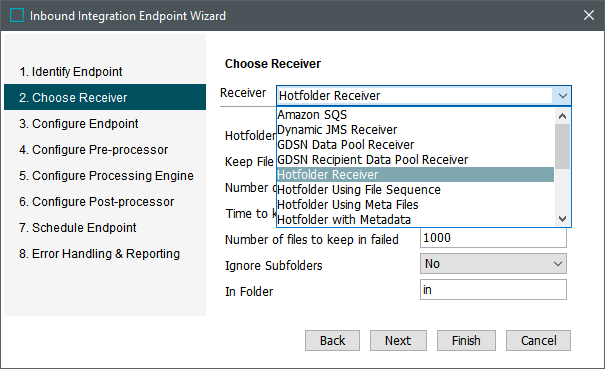
-
Select the receiver to be used for the inbound endpoint. The available standard receivers are listed in the Receiver Methods section below.
-
Click the Next button to display IIEP - Configure Endpoint.
Receiver Methods
Data being imported into STEP via an IIEP can originate using any of the IIEP receiver methods described below. When the data is available, the IIEP processes based on its configuration, and then performs the import. Pictured below is an example of some receiver methods available.

Note: Import Manager does not require a receiver method since the user chooses a single file for import. For more on Import Manager, refer to the Import Manager topic.
The following receiver options are only available when importing data using an IIEP, and some are based on a license.
| Method | Description |
|---|---|
|
Amazon SQS |
Receives messages from an Amazon SQS (Amazon Simple Queue Service). Refer to the Amazon SQS Receiver topic. |
|
Dynamic JMS Receiver |
Dynamic Java Message Service (JMS) receivers are system dependent. By default, the Dynamic JMS Receiver option lets you consume and dequeue messages on defined queues. Unlike the JMS Receiver mentioned above, this receiver allows customers to supply the vendor-specific JMS libraries and JNDI configuration. Refer to the Dynamic JMS Receiver topic. |
|
The GDSN solution must be implemented fully before the GDSN Data Pool Receiver method is available and functional. Refer to the GDSN Receiver Solution Enablement topic. |
|
|
GDSN Recipient Data Pool Receiver |
The GDSN solution must be implemented fully before the GDSN Recipient Data Pool Receiver method is available and functional. Refer to the GDSN Receiver Solution Enablement topic. |
|
Hotfolder Receiver |
Enables setup of a standard data hotfolder, typically on the application server. Refer to the Hotfolder Receiver topic. |
|
Hotfolder using file sequence |
Enables setup of a standard data hotfolder, typically on the application server, where file names include sequence ID to determine the file processing order. Refer to Hotfolder Receiver Using File Sequence topic. |
|
Hotfolder using meta files |
Enables the setup of a standard data hotfolder, typically on the application server, where one or more simple .txt meta files determine the file processing order. Refer to the Hotfolder Receiver Using Meta Files topic. |
|
IBM MQ SSL |
IBM MQ SSL uses MQ series Secure Sockets Layer and enables data exchange across IBM and non-IBM platforms. Refer to the IBM MQ SSL Receiver topic. |
|
JMS Receiver |
Java Message Service (JMS) receivers are system dependent. By default, the JMS Receiver option lets you consume and dequeue messages on defined queues. Refer to the JMS Receiver topic. |
|
Kafka Receiver |
Apache Kafka is an open-source distributed event-streaming data platform. The Kafka Receiver enables STEP platforms integrated with Apache Kafka to use background processes for inbound message processing from a Kafka topic with a single partition. Refer to the Kafka Receiver topic. |
|
Kafka Streaming Receiver |
The Kafka Streaming Receiver integrates STEP with Apache Kafka to read messages from a topic, with parallelization based on partitions and without the use of individual background processes per message. Refer to the Kafka Streaming Receiver topic. |
|
Oracle AQ Receiver |
Oracle Advanced Queuing (Oracle AQ) enables messages to be exchanged between two systems. Refer to the Oracle AQ Receiver topic. |
|
Product Data Exchange Receiver |
STEP receives data from the Product Data Exchange (PDX) platform via the default PDX Inbound Integration Endpoint and the API. Refer to the PDX Receiver topic. |
|
REST Receiver |
Representational State Transfer (REST) is a software architecture style used to design web services. Refer to the REST Receiver topic. |
|
REST Direct Receiver |
Representational State Transfer (REST) is a software architecture style used to design web services. This receiver sends a REST call that immediately initiates an import process. Refer to the REST Direct Receiver topic. |
|
Web UI File Loading Receiver |
Receiver used for the Web UI 'File Loading Widget' for non-hotfolder-based receiver types. Refer to the Web UI File Loading Receiver topic. |